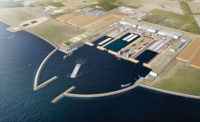
Coping with the titanic force of America’s largest river is one of the U.S. Army Corps of Engineers’ perpetual responsibilities. Starting in 1866, Congress authorized the Corps to improve its navigability by dredging, removing snags and clearing trees from the river’s banks. “The river flows over sand and clay, not bedrock, and is always cutting a new channel,” explains Col. Brian D. Sawser, commander of the Corps’ Memphis District. “Since 1921 for navigation reasons and commerce we are trying to keep the channel in its spot.” The Corps is mandated to maintain the channel at 9 ft deep and 300 ft wide.
One of the longstanding items in the Corps’ toolkit are wing dams, dikes typically extending hundreds of feet out into the river, perpendicular to the shore. Most often built with piles and stone, they force the water towards the center of the river, speeding its flow, causing it to clear sediment and scour away sandbars. “The roughly 1,000 dikes built by the Corps over decades have vastly reduced the amount of dredging needed,” says Sawser. Early ENR articles described them as “contraction works.”
The most imposing control structures are the system of levees bracketing the lower Mississippi for 1,000 miles, from Cairo, Ill., to the Gulf of Mexico, as well as its tributaries and floodways. They constitute the largest man-made structure on earth. Throughout the 19th century, they were built under the jurisdiction of local levee boards, and their conditions varied. The levee system has reduced the river’s alluvial valley floodplain by 90% from its original size of 37,500 sq miles.
The Corps was granted partial oversight of the levees in 1879, with the formation of the Mississippi River Commission, consisting of three Corps members, one representative from the National Oceanic and Atmospheric Administration, and three civilians, two of whom must be civil engineers. The Commission provides policy advice, engineering direction and oversees the planning and execution of improvements affecting navigation and flood control.
The transformative event in the river’s history was the flood of 1927. Months of unusually heavy rain across the Midwest and South filled it bank-full, eventually leading to levee ruptures or overtoppings in 17 places, forcing 630,000 people from their homes, inundating 25,000 sq miles, and leaving roughly 500 people dead. To prevent future catastrophes, the Corps proposed and Congress passed a comprehensive flood control program, giving the federal government full responsibility for the Mississippi River for the first time.
The Flood Control Act of 1928 had four elements: levees; floodways to detour excess flows; channel stabilization; and tributary basin improvements. The first floodway to be built was the Bird Point-New Madrid Floodway in southeast Missouri. Completed in 1932, its levee contains embedded pipes that can be packed with explosives and detonated to breach the levee and divert water into the 205-sq-mile floodway. It has been activated twice, in 1937 and 2011.
The largest single flood control complex on the river is the Old River Control Structure, a collection of four structures in central Louisiana. A floodgate system regulating the flow of water from the Mississippi into the Atchafalaya River, it prevents the Mississippi from changing course. The first three components were completed in 1963 and the fourth added in 1986 after a 1973 flood badly damaged portions of the original structure. The Bonnet Carre Spillway, a 1.5-mile-long, mechanically operated weir located 12 miles west of New Orleans, allows overflow volume from the river to flow into Lake Pontchartrain. The spillway has been opened 15 times since 1937, and left open anywhere from 13 days to 75 days.
Another river control tactic, subject to endless debate, is man-made cutoff channels through meanders. Advocates said they improved navigation channels and lowered flood heights. Detractors argued they caused excessive bank failures and upset a river’s equilibrium. The Commission banned them in 1884. But a pro-cutoff faction within the Corps, led by General Harley B. Ferguson, gained momentum in the 1920s. Ferguson was appointed president of the Commission in 1932, and over the following decade the Corps excavated 14 man-made cutoffs, shortening the river by 132 miles. While initially offering navigation improvements, they caused the river to respond over ensuing decades in ways ultimately judged to be negative because of how sediments shifted. River morphology was still an evolving science at the time.
Refining the Revetment Process
The Corps’ largest continual task is maintaining the integrity of the levees. Beginning in 1881, the favored approach was the crafting and installation of huge timber mattresses. Barge loads of willow branches were bound into bunches (fascines) with wire, and assembled into mattresses 150 ft to 300 ft wide and 1,000 ft to 1,200 ft long. The mattresses were fabricated in the water by crews of 100 workers at the site where they were being placed. Once assembled, they were ballasted with stone and sunk, extending from the waterline down the underwater levee slope and 50 ft along the flat river bed. The operation involved four boats for worker housing, numerous barges for supplies of willow branches and stone, a barge-mounted crane, a pump barge for servicing hydraulic hoses, and a concrete-mixing and paving plant for casting a concrete slab extending up the levee slope from the waterline.
Related Link:
Want More Construction History from ENR?
Supplies of willow declined as the land along the river was deforested. The valley’s rich bottomland was cleared for agriculture, and logging fueled fleets of wood-burning steamboats.
A new type of revetment was developed in Japan in the early 20th century. Articles describing a flexible concrete mattress revetment appeared in Engineering News in 1912 and 1913. A 1918 article in ENR by Japanese engineer B. Okazaki touted them as more economical since they resisted scour, which over time damaged and destroyed timber mattresses.
The Corps began turning to articulated concrete mat revetments in the 1920s, but timber mats remained in use as well. By 1930, the Corps was fabricating concrete mats in two sizes. Some mattresses featured rectangular slabs 1 ft x 4 ft, strung together with cables, while others had blocks 5 ft x 7 ft. By 1928, concrete mats represented a significant share of revetment work. An ENR article that year stated, “The floating mixing plant travels up and down the line of barges, filling the mat forms in succession. … Two ten hour shifts were being worked … the time of 1½ minutes for mixing and 15 seconds each for discharging and filling.” After curing for six days, the 140-ft x 250-ft mats were transferred to a steel mat boat equipped with rollers and gradually lowered into place in the river. At that time, the sinking plant could place an average of 70,000 sq ft of mat per day. They continue to be the standard form of revetment, with 400 Corps staffers placing an average of 18 million sq ft of matting per year.
Seepage is a threat to the integrity of levees. Two tools to combat it are landside berms and relief wells. Landside berms are auxiliary embankments, 25 m or 50 m wide, along the toe of a levee. Relief wells, positioned on the land side of levees, send water to ditches or small canals running further inland.
Timber and concrete mat revetments can only be placed at certain times of the year. “Revetment season is late summer to late fall, when the river is low enough,” explains Sawser. In 1934, the Corps experimented with a new form of revetment “that can be used in emergencies to combat an unexpected bank attack during high river stages.” A blanket of gravel is placed on the bank, and then a layer of tetrahedron-shaped concrete blocks is set on top, serving as armor to keep gravel from washing away.
One promising new practice is floodplain reconnection. One of the largest to date involved a 16,000-acre failed soybean farm near Monroe, La., ringed by a levee. The Nature Conservancy and the U.S. Fish and Wildlife Service planned to breach the levee and let the Ouachita River, a tributary of the Mississippi, reconnect the property. Shortly before they were going to carry it out in 2009, nature did it for them. The site, now part of the Upper Ouachita National Wildlife Refuge, can draw off 300,000 acre-ft of water during flood periods. “The Conservancy is now working on several other floodplain reconnection project opportunities where we already have a conservation footprint or wetland easement,” says Shelly Morris, the Conservancy’s freshwater conservation director for Kentucky and Tennessee.
This array of tools and tactics has reduced the risk of the river causing havoc during periods of high water. “The Mississippi passed more water downriver in 2011 than in 1927, without any levee breaches,” says Sawser.





